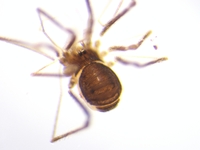Distribution Records
PDF
Vetting Levels |
|
Adult phenology:
High Mountains (HM) ≥ 4,000 ft.
Low Mountains (LM) < 4,000 ft.
Piedmont (Pd)
Coastal Plain (CP)
Click on graph to enlarge
|
 |
|
| synonym | |
| taxonomic_comments |
The sole member of this genus (Shear, 1986; Cokendolpher and Lee, 1993) |
| species_comment |
|
| id_comments |
Only females are known and the species is believed to be parthenogenic (Shear, 1986). The sclerotized tergites are dark brown, contrasting strongly with the pale, whitish connecting membrane between them. Black denticles cover large areas of both the cephalothorax and abdomen. Hesperonemastoma kepharti is similar in size and in the contrast between the dark sclerotized plates and whitish connecting membrane. That species is more blackish, however, |
| total_length |
0.89 mm (Shear, 1986) |
| structural_features |
The palps are extremely thin and about as long as the first and second pair of legs; the tibia and tarsus are covered with plumose setae and the terminal claw is absent (Shear, 1986). The femor, patella, and tibia of the walking legs are ornamented with large socketed setae, spines, and curly hairs. |
| silk_web |
|
| fld_guide_descriptions |
|
| online_photos |
Photographs are included on BugGuide, but under the genus name |
| prey |
Probably consists of mites, collembolans, and myriapods (Shear, 1986) |
| predators |
|
| behavior |
|
| distribution_reference |
Banks (1911) |
| technical_reference |
Shear (1986) |
| adult_id | 1 identifiable by photo 2 identifiable by photo of specific features and/or supplementary info 3 identifiable from specimen only |
| abundance |
Too few records exist to estimate either the frequency of occurrence or abundance of this species in North Carolna |
| distribution_comments |
Probably found throughout the Mountains in appropriate habitats. This species is fairly widespread in the North, ranging from New England to the Great Lakes region. It ranges as far south as South Carolina in the Southern Appalachians (Shear, 1986). |
checklist_mt_high
>=4,000 ft. | |
checklist_mt_low
<4,000 ft. | |
checklist_pd
Piedmont | |
checklist_cp
Coastal Plain | |
| habitat |
This species is associated with cool, moist microclimates and appears to occur primarily in hardwood-dominated forests rather than stands of conifers; several specimens have been found in Rhododendron leaf litter (Shear, 1986). Records in North Carolina come from both high elevations (over 5,000 ft in some cases), as well as fairly low elevations, such as the Swannanoa River valley. |
| observation_methods |
Usually collected using Berlese funnels (Shear, 1986) |
| state_protection |
Arachnids are not protected under state law, although permits are needed to collect them in State Parks and other public and private nature preserves |
| NHP_ranks |
[GNR] [S3S4] |
| NHP_status |
|
| status_comments |
We have relatively few records for this species but that may be due to the specialized methods needed to collect this species. Although at least somewhat specialized in terms of its habitats, its habitats appear to be widespread within the Mountains. As a species associated with cool, moist microclimates, it is likely to be vulnerable to the warming and drying effects of climate change as well as disturbances that open up the forest canopy. |
Photo Gallery for Crosbycus dasycnemus No common name |
 | Recorded by: Carol Tingley
Avery Co.
Comment: |  | Recorded by: Carol Tingley
Avery Co.
Comment: |
|
 »
»
 »
»